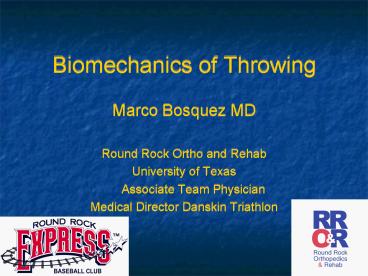Biomechanics of Throwing PowerPoint PPT Presentation
1 / 26
Title: Biomechanics of Throwing
1
Biomechanics of Throwing
- Marco Bosquez MD
- Round Rock Ortho and Rehab
- University of Texas
- Associate Team Physician
- Medical Director Danskin Triathlon
2
Goals
- Stages of mechanics
- Forces acting at shoulder and elbow
- Relationship of faulty mechanics to injury
- Differences between children and adults
- Different types of pitches
3
Biomechanics
- 6 Phases
- Wind-up
- Stride
- Arm Cocking
- Arm Acceleration
- Arm Deceleration
- Follow Through
4
Wind-up
- Begins with initiation of leg movement
- Ends when pitchers lead leg has reached maximum
height - Minimal kinetics and muscle activity in both
shoulder and elbow
5
Stride
- Ends when lead foot makes contact
- Arm abducted 90o, elbow flexed 90o
- Arm externally rotated 30o-80o
6
Arm Cocking
- From foot contact until throwing shoulder reaches
maximum external rotation - Pelvis and upper trunk rotate to face batter
- Arm reaches maximum external rotation up to 180o
- Gleno-humeral rotation
- Scapulo-thoracic motion
- Extension of spine
7
Arm Acceleration
- Lasts until ball release
- Torques at shoulder at elbow produce rapid arm
acceleration
8
Arm Deceleration
- Ball release to max internal rotation
- Arm abducted at 90o regardless of style
- Highest joint loads
9
Follow-Through
- From max IR until pitcher reaches balanced
fielding position - Trunk and legs dissipate energy in the arm
10
Shoulder
- Late Cocking
- RTC peak compressive force of 650 N
- Biceps begins to fire
- Horizontal add.100 Nm, IR 70 Nm
- Humeral head translates posteriorly
11
Shoulder
- Acceleration
- Shoulder loads are minimal
- Horizontal abduction returns to neutral
- Humeral head recenters
- Triceps early pecs, lats, serratus ant. late
12
Elbow
- Late Cocking/Acceleration
- Varus torque of 64 Nm at elbow during late
cocking and early acceleration - UCL generates 54 (35 Nm) of this force
- UCL failure strength 32 Nm
13
Elbow
- Late Cocking/Acceleration
- Valgus force and rapid elbow extension produce
tensile stress to medial restraints - UCL anterior bundle is primary restraint to
valgus force from 30o to 120o of flexion - Flexor-pronator mass
- Medial epicondyle apophysis
- Ulnar nerve
14
Elbow
- Late Cocking/Acceleration
- Compression of radial head and capitellum
- Compressive forces of 500 N (125) as elbow moves
from 100o to 20o of flexion - Shear forces posteriorly
15
Shoulder/Elbow
- Release/Deceleration
- Highest joint loads
- Distraction at elbow and shoulder
- Large proximal forces needed
- Shoulder 125 wt
- Elbow 100 wt
16
Shoulder/Elbow
- Release/Deceleration
- Violent eccentric muscle contractions
- Biceps contracts to stabilize shoulder
compressive force of (1000N) - Biceps decelerates rapid elbow extension (60Nm)
17
Biomechanical Factors
- 50 of velocity attributed to mechanics
- Top two factors
- Timing of shoulder rotation and elbow extension
- Trunk/Shoulder cocking and distance
18
Biomechanical Errors
- Lead foot too open
- Lead foot pointed outward
- Early shoulder rotation
- Late shoulder rotation
- Leading with elbow
- Decreases ball speed, increases arm stress
19
Importance of Pitch Type
- Fastball
- High kinetics
- Fast arm speed and trunk rotation
- Forearm neutral
- Wrist from extension to flexion
- Ball speed high
20
Importance of Pitch Type
- Change-up
- Low kinetics
- Slow arm speed and trunk rotation
- Forearm neutral
- Wrist from extension to flexion
- Ball speed low
21
Importance of Pitch Type
- Curveball
- High kinetics
- Slow arm speed and trunk rotation
- Forearm supinated
- Wrist from radial to ulnar deviation
- Ball speed low
22
Age Differences
- Ball velocity increases with age
- Shoulder and elbow velocity increases with age
- Shoulder and elbow distraction forces increase
with body weight - No differences found in mechanics
23
Summary
- Children pitch with less force but similar
mechanics to adults - Learning proper mechanics as early as possible is
beneficial - Deviations from proper mechanics can lead to
joint stress and potential injury
24
Summary
- The change-up is the easiest and safest off-speed
pitch - The curveball is a difficult, stressful off-speed
pitch
25
Summary
- Pitching is a kinetic chain
- Good conditioning of all elements in the chain is
critical - Good conditioning does not prevent overuse
26
- Marco Bosquez MD

